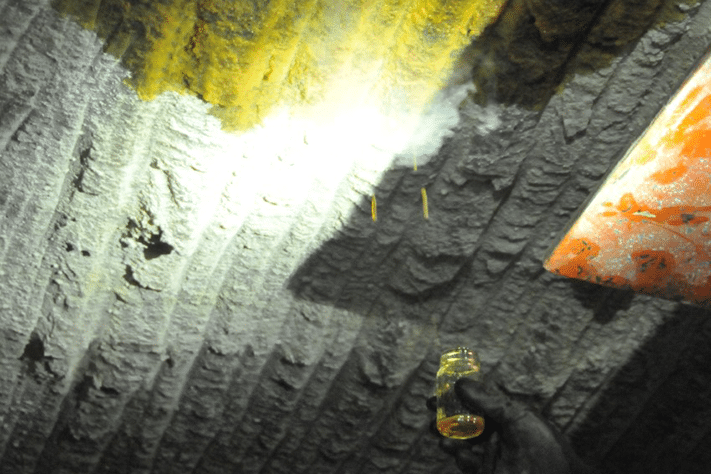It’s autumn 2018 and Jon Gluyas from Durham University and Mirek Słowakiewicz from Warsaw University are preparing for a visit to the Boulby mine in Yorkshire to look at some oil staining reported in the interval of polyhalite that is being mined for fertilisers. Just before they are heading off, they get a phone call from the mining company saying that an active seep had been hit and oil is flowing out of the roof of the gallery.
“This was a once in a life-time opportunity,” Jon recalls, “as it presented us with the opportunity to sample the fresh oil for further analysis.” Based on the biomarker study they carried out using the sampled oil, the team could subsequently rule out that the oil was derived from established source rocks in the area such as Upper Carboniferous Namurian black shales and coals or Upper Jurassic Kimmeridge Clay mudstones.
“The biomarkers clearly point to a restricted carbonate-evaporite depositional environment, which strongly resembles the Upper Permian Kirkham Abbey Formation,” Mirek adds. The Kirkham Abbey Formation is the onshore equivalent of the Hauptdolomit, which is the main carbonate of the second Zechstein evaporitic cycle in the Southern North Sea. It was deposited mainly on a carbonate ramp and associated slope, with more restricted conditions developing in lagoonal settings.
The Hauptdolomit (or Main Dolomite) is a well-known source rock in Germany and Poland – the eastern parts of the Southern Permian Basin (SPB), but to date it had never been proven in the western part of the SPB.
An interesting aspect of the oil find in the Boulby mine is the fact that the oil must have somehow migrated through halite. Whereas halite is generally believed to be the ultimate seal, if the oil is from the Kirkham Abbey Formation indeed, which is around 200 m deeper than the mine, the oil must have been migrating upward through an interval of salt. The authors believe that transient faults form a conduit; i.e. faults that heal quickly through to the mobility of the salt.

Relevance for Mid North Sea High prospectivity
Given recent developments around the Mid North Sea High, the conclusion that a working Zechstein source rock is present in this part of the Southern Permian Basin, is good news. Although oil and gas have previously been found in the Zechstein of the Southern North Sea (see map), so far it was not clearly demonstrated that it could have been sourced from the Zechstein itself.
Only last year, ONE Dyas completed wells 42/04-1 and 42/04-1Z on the Ossian (Zechstein) and Darrach (Carboniferous) prospects. The 42/04-1 well proved oil in 145 ft gross Zechstein limestone, with the Carboniferous targets believed to be water-wet. The sidetrack proved oil in 12 ft gross Zechstein reservoir. The well flowed maximum 3,500 bpd with a 79% water cut. 62 tonnes of oil and 15,000 Sm3 gas were recovered during clean-up but the test was abandoned without completing planned EWT. Operatorship of the licence has since been transferred to Spirit Energy.
In addition, oil and gas were found in the Kirkham Abbey Formation (Hauptdolomit) in the West Newton onshore well in 2019, drilled by Rathlin Energy. The company is now actively working on further appraising the discovery and handed in plans to drill two more wells.
Other companies such as Egdon Resources, Ardent Oil and Draupner Energy are also actively pursuing the Zechstein play in the area, which further adds to importance of this finding.
Although the Southern North Sea for many people is a synonym for the gas basin, one of the first exploration wells drilled in the area encountered oil in Zechstein carbonates: 48/22-1 (Blythe on map), drilled by Burmah Oil in 1966. Good shows were observed in the Hauptdolomit interval and the interval tested 2000 barrels/day. However, production decreased during the test and the conclusion was drawn that the accumulation was not viable. The well nowadays underlies the Dudgeon windfarm. In 1967, well 48/21-1 also tested oil in the Zechstein.
A new and working petroleum source rock on the UK Continental Shelf (Upper Permian, offshore Yorkshire) – Mirosław Słowakiewicz, Jon Gluyas, Adam Kowalski, Thomas Edwards, Samuel Słama, Mike Mawson, Maurice E.Tucker, Paul Scovell, Israel Polonio. https://doi.org/10.1016/j.marpetgeo.2020.104605
HENK KOMBRINK





